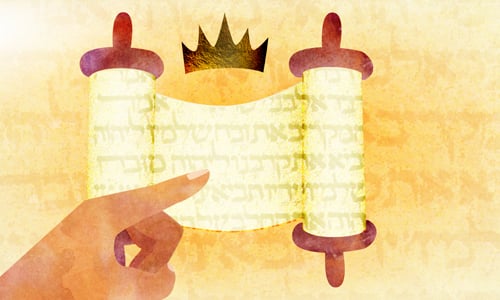The mitzvah of Sefirat HaOmer1 (counting the Omer) is found in parshat Emor, which is always read during the period of Sefira. It is also read on the second day of Pesach, the day that we begin the counting of the Omer.
What is the reason for the mitzvah to count? According to many,2 it is a preparation and gives us a spiritual way to prep ourselves for the holiday of Shavuot.
The Chinuch3 tells us: "We are commanded to count from the day after the first day of Pesach until the day of the giving of the Torah, to give guidance to our souls, to have great yearning for the honorable day in our hearts, 'like a servant who longs for shade,'4 constantly counting, when will come the time that he pines for, to go free, because the counting reveals that this person’s whole hope and yearning is to reach that day."
This will help us understand why we don't say the blessing of Shehecheyanu at the start of the count. It is, firstly, because it is a preparatory mitzvah, and we don't say Shehecheyanu on a mitzvah that is a preparation for something else. For example, when we search for chametz before Passover, we do not say Shehecheyanu, since it is a preparation for Passover.5
A second reason is that the count represents a longing and anticipation for something we have not fully have. Therefore, it is associated with discomfort, which does not warrant this joyous blessing of thanks and celebration.6
Today, according to some opinions,7 the mitzvah of Sefirat HaOmer is zecher lamikdash, meaning that it is not the same as in Temple times, when the Omer offering was brought. Now that we don't have the Temple, we count the Omer in remembrance of Temple times. But we still say the blessings and it has the same spiritual effect on us, as we will discuss later in this article.
The Zohar8 says that the seven weeks we count are like the seven days that are counted before mikvah. Through this, we purify ourselves, so that we can enter the chupah on the day of the Giving of the Torah, Shavuot.
Rabbi Schneur Zalman of Liadi, when putting together the siddur that many, including Chabad, use, was very particular in every detail, formulating the liturgy, the order, and more. It follows the nusach (liturgy) of the Arizal, but leaves out the deep spiritual meditations of the Arizal. He did that so it should be accessible for all Jews.
Interestingly, when the Alter Rebbe compiled his siddur, he had 60 versions of the Ari's siddur that he compared and referenced before coming up with his final product.9
Whereas the Ari's siddur ends with meditations, Rabbi Schneur Zalman put Sefirat HaOmer at the back of the siddur. Why did he make this change?
This is not arbitrary, especially when we know how particular he was about every detail. The end of a book is the culmination of the work, and in it, you can find the essence and the central purpose of the work.
The Ari's siddur ends with meditations10 of the higher spiritual realms because it is a siddur that was made for the select few who are at such a high level that their prayers affect this world and the higher spiritual realms, bringing everything in sync with G‑d's purpose. Appropriately, it ends with meditations.
Rabbi Schneur Zalman of Liadi's siddur, as was mentioned, is for every individual Jew. Its central theme is the effect on the individual, and it culminates with Sefirat HaOmer, because somehow Sefirat HaOmer encapsulates the central theme of the siddur. How does it do that?
Mitzvot generally fall into one of two categories: The first are mitzvot that require action, like putting on tefillin, lighting Shabbat candles, eating matzah, etc. Even a slight action, like speaking, saying words like the reading of the Megillah or retelling the story of the Exodus from Egypt, etc.
The second type of mitzvah is the kind that is in the heart, like love and fear of G‑d.
The mitzvah of prayer is unique in that, while it requires the action of using one’s lips, it also is in the heart, as one must plead and beseech G‑d with intent. The Rambam11 says, "The obligation of this mitzvah is that a person should beseech and pray every day, by saying praises of G‑d, followed by asking for his needs through requesting and beseeching, and after that, to give praise and thanks to G‑d for the good He has given him." Requesting and beseeching require that you understand what you are saying, and it comes from the heart. If not, it isn't prayer.12 So prayer has both the qualities of action and heart.
While other mitzvot require proper intent, the intent itself isn't the actual mitzvah, but when it comes to prayer, the intent itself is the mitzvah.
The same is true about Sefirat HaOmer. The law is that one must count, but if they do not understand the words in Hebrew, they can say in any language that they understand, since both intent and speech are part of the mitzvah.13 So Sefirat HaOmer is like prayer, in that it has both qualities of action and heart.
Another way prayer and Sefirat HaOmer are alike is in their effect on the individual.
When praying we are meant to stand before G‑d, "like a servant before his master."14 And the Rambam15 says, "One should clear his heart of all thoughts and see himself as if he stands before the Shechina." When one prays in this way, it lifts them to a higher level than before, making them a completely different person.
The same is true regarding Sefirat HaOmer. The purpose of Sefirat HaOmer is to change ourselves spiritually, every day working on a different aspect of our spiritual makeup. As we say in the "Ribono Shel Olam" prayer following Sefirat HaOmer, "You have commanded us ... to count Sefirat HaOmer in order to purify us from our evil and impurities ... so that the souls of Your people Israel may be cleansed from their defilement." Just like prayer, the counting of the Omer changes a person.
There is a third way that prayer and Sefirat HaOmer are alike, and different from most other mitzvot. Most mitzvot require action that, after completion, require no more follow up.
When it comes to prayer, however, the point is to beseech and pray for one’s needs, even though one doesn’t know if and when their requests will be fulfilled, which would be the completion of what they are praying for. The act of prayer, asking for ones needs, although it may not have been concluded, is the mitzvah. In a way, prayer is the preparation for the fruition of our requests, and it is this preparation that is the actual mitzvah.
The same is with Sefirat HaOmer: it is only a preparation for receiving the Torah, for Shavuot. And the preparation, the counting, longing and anticipation, is the actual mitzvah.
You might think that an ordinary individual’s prayer is not as powerful as that of the special few who pray with the Ari's meditations. But Sefirat HaOmer teaches us otherwise.
When you think about it, you will realize that this counting is very powerful, and we see its strength in the holiday it brings: Shavuot.
Shabbat is established by G‑d. No matter what, every seven days you have Shabbat—it is totally out of our control. Most holidays are set to a date on the calendar. We Jews sanctify the months of the year, establishing when the new month begins, but it generally follows the cycle of the moon. In that we have some control.
However, Shavuot is not set to a date on the calendar, rather it is set to the count of the Omer. We count 49 days and the 50th is Shavuot. It is totally in our control.
We see the power of Sefirat HaOmer in a few ways. First, outside of Israel, instead of every holiday being one day, we add an extra day. The reason for this is because in the times that we would sanctify the new month following the testimony of two witnesses who saw the new moon. The community outside of Israel wouldn't know exactly when the new month began until a while later. To deal with this ambiguity, it was established that outside of Israel, they would celebrate a second day, just in case the new month began a day later. So the extra day of every holiday is because of doubt.
The exception to this rule is Shavuot. Since Shavuot is after 49 days of counting the Omer, there is never a doubt when Shavuot is. If so, why do we have a second day of Shavuot? It is the rabbis who made all the holidays the same.16 Different than Sukkot and Pesach, the extra day of Shavuot was never because of a doubt. Therefore, it is with a greater measure of sanctity than the extra days of the other holidays.17
It is Sefirat HaOmer that establishes when we celebrate Shavuot.
The second way is how our individual counts effect Shavuot. According to many,18 if someone crosses the International Dateline during Sefira and his count is off by a day, he will have to celebrate Shavuot according to his count, either a day earlier or later than everybody else.
And finally, Sefirat HaOmer draws G‑d's blessing into the world, as the prayer after Sefirat HaOmer continues, "And through this, abundant bounty will be bestowed in all the worlds." And these blessings are drawn into the details, as the next words tell us, "And rectify our nefesh, ruach and neshamah19 from every baseness and defect, and purify and sanctify us with Your supernal holiness."
Similarly, the individual prayer of every single Jew is very powerful, even though it is focused on his or her personal needs. Prayer is not just to draw down the blessings that are already in the world. In prayer we say, "It should be the will before You," because we, so to speak, draw from beyond existence a new will20 that didn't exist until then. And this new will is drawn into the details, to heal someone who wasn't meant to be healed, to grant children to someone who was meant to be barren, to rain on a place where there was supposed to be a drought, etc. When a new will is drawn into the world, it affects all of existence, raising it higher than it ever was before. So, like Sefirat HaOmer, the prayers of an individual are extremely powerful: they change the world.
Now we can understand why Rabbi Schneur Zalman of Liadi put Sefirat HaOmer last in his siddur, because it encapsulates the essence and the central theme of individual prayer, which is the point of his siddur.
Through our counting Sefirat HaOmer, which is zecher lamikdash, and through studying its laws, we will merit the coming of Moshiach and the rebuilding of our Holy Temple, the Beit Hamikdash, in Jerusalem. And we will certainly be able to count the Omer in its proper way, as we say right after counting, every night of Sefirat HaOmer, "May the Merciful One restore unto us the service of the Beit Hamikdash to its place, speedily in our days; Amen, Selah." May it happen soon.21








Join the Discussion